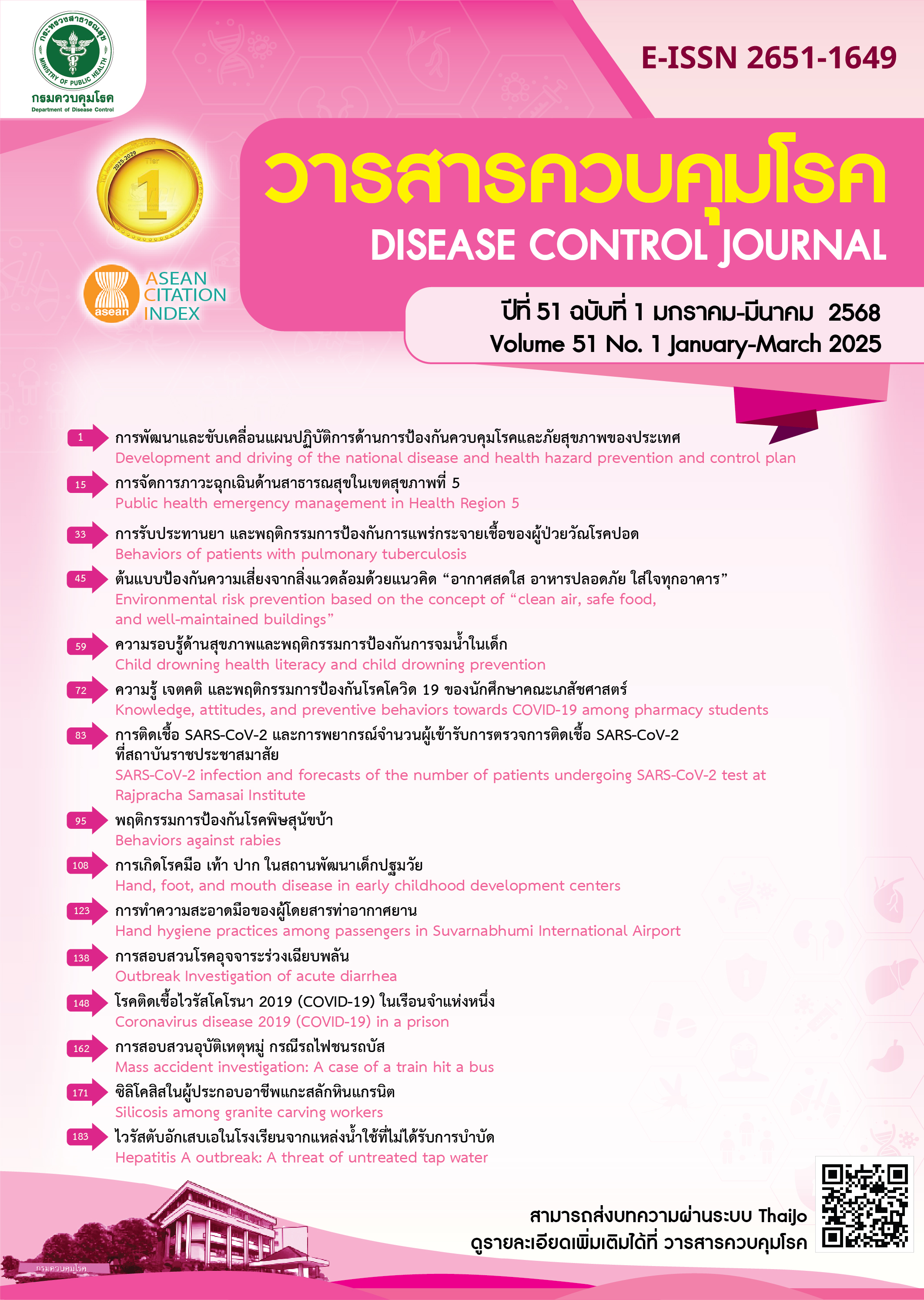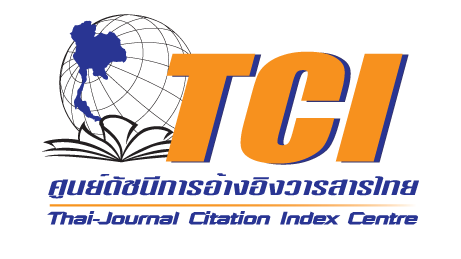Child drowning health literacy and child drowning prevention behavioral of households in Khao Samsib Sub-district, Khao Chakan District, Sa Kaeo Province
DOI:
https://doi.org/10.14456/dcj.2025.5Keywords:
child drowning, drowning prevention behavior, health literacy, householdsAbstract
Child drowning is the leading cause of death in children under 15 years old. This cross-sectional study aimed to investigate the health literacy related to drowning prevention in children and its associated with drowning prevention behaviors among caregivers of Khao Samsib Subdistrict, Khao Chakan District, Sa Kaeo Province. A total of 291 households were randomly recruited into the study. Household representatives were interviewed using structured questionnaire. The content validity index (CVI) values for individual items (I-CVI) and the scale (S-CVI) ranged from 0.83 to 0.97. Reliability was assessed using Cronbach's alpha. The reliability coefficient of knowledge and skills in preventing drowning in children were 0.72 and 0.74, health literacy in preventing drowning in children was 0.82, and household behaviors in preventing drowning in children was 0.74. Descriptive statistics and chi-square tests were used to analyze the data. The study found that 52.9% of household representatives were at a sufficient level of knowledge about drowning prevention. About half were at a sufficient level of decision-making skills, implementation, and information access (53.6%, 52.6%, and 51.9%, respectively). However, understanding and inquiry skills were at an insufficient level (52.9% and 50.2% respectively). Drowning preventive behaviors, 80.5% was at a good level and 83.8% was at a low level of knowledge on drowning prevention. Skills related to drowning prevention, 85.1% was at good level. Educational status, and knowledge of drowning prevention were significantly associated with drowning preventive behaviors (p-value<0.05). To prevent drowning and deaths from drowning in children, activities should be organized to promote health literacy and enhance knowledge of proper resuscitation techniques among community people.
Downloads
References
World Health Organization. Preventing drowning: an implementation guide [Internet]. 2017 [cited 2023 Mar 22]. Available from: https://www.who.int/publications/i/item/9789241511933
Ministry of Public Health (TH), Department of Disease Control. Drowning Prevention Course for Program Manager [Internet]. [cited 2023 Mar 22]. Available from: https://e-learningdrowning .com/book-and-manual (in Thai)
Ministry of Public Health (TH), Department of Disease Control. Drowning Report [Internet]. [cited 2023 Mar 22]. Available from: https://dip.ddc.moph.go.th/satdrowning/ (in Thai)
Nutbeam D. Health literacy as a public health goal: A challenge for contemporary health education and communication strategies into the 21st century. Health Promotion International. 2000:15(3);259-67.
Ministry of Public Health (TH), Department of Disease Control. An Evaluation of Health Literacy in Prevention, Control Disease and Health Hazard of the Thai people during B.E.2022 [Internet]. [cited 2023 Mar 22]. Available from: https://datariskcom-ddc.moph.go.th/download/การประเมินความรอบรู้ด้-4/ (in Thai)
Farizan NH, Sutan R, Kulanthayan K. Effectiveness of “Be SAFE Drowning Prevention and Water Safety Booklet” intervention for parents and guardians. Iranian journal of public health. 2020;49(10):1921-30.
Hossain M, Mani KK, Sidik SM, Ks H, Fazlur Rahman A. Randomized controlled trial on drowning prevention for parents with children aged below five years in Bangladesh: a study protocol. BMC public health. 2015;15(1):1-7.
Peden AE, Franklin RC, Pearn JH. The prevention of child drowning: the causal factors and social determinants impacting fatalities in portable pools. Health Promot J Austral. 2020;31(2):184-91.
Farizan NH, Mani KK, Sutan R, Hod R. A concept paper on improving parental knowledge and practices on water safety and their children: a guide for drowning prevention. Int J Acad Res Bus Soc Sci. 2021;11(15):262-71.
Scarr J, Jagnoor J. Identifying opportunities for multisectoral action for drowning prevention: a scoping review. Inj Prev. 2022;28(6):585-594.
Leavy JE, Crawford G, Leaversuch F, Nimmo L, McCausland K, Jancey J. A review of drowning prevention interventions for children and young people in high, low and middle income countries. J Community Health. 2016;41(2):424-41.
Scarr J, Jagnoor J. Identifying opportunities for multisectoral action for drowning prevention: a scoping review. Inj Prev. 2022;28(6):585-94.
Wayne WD. Biostatistics: A foundation of analysis in health science. 7th ed. New York: John Wiley & Sons; 1999.
Bloom BS. Handbook on formative and summative evaluation of student learning. New York: McGraw-Hill book company; 1971.
Kaeodumkoeng K, Junhasobhaga J. A Development and Testing of Health Literacy on Disease Prevention and Control Assessment form for Public Health Officers. Romphruek Journal of the Humanities and Social Sciences of Krirk University. 2021;39(2):193-220. (in Thai)
Yupvattanapan P. Needs and Received Need Response among Mothers of Children Hostipitalized in Pediatric Intensive Care Unit at Maharaj Nakorn Chiang Mai Hospitals [dissertation]. Chiang Mai: Chiang Mai University; 1998. (in Thai)
Leavy JE, Crawford G, Leaversuch F, Nimmo L, McCausland K, Jancey J. A review of drowning prevention interventions for children and young people in high, low and middle income countries. Journal of community health. 2016;41(2):424-41.
Hossain M, Mani KK, Sidik SM, Ks H, Fazlur Rahman A. Randomized controlled trial on drowning prevention for parents with children aged below five years in Bangladesh: a study protocol. BMC public health. 2015;15(1):1-7.
Nanthamongkolchai S. Child Rearing in Thai Families Qualitative Study. Songkla Research and development office. Prince of Songkla University; 2004. (in Thai)
Wallis BA, Watt K, Franklin RC, Taylor M, Nixon JW, Kimble RM. Interventions associated with drowning prevention in children and adolescents: systematic literature review. Inj Prev. 2015;21(3):195-204.
Downloads
Published
How to Cite
Issue
Section
License
Copyright (c) 2025 Disease Control Journal

This work is licensed under a Creative Commons Attribution-NonCommercial-NoDerivatives 4.0 International License.
Articles published in the Disease Control Journal are considered as academic work, research or analysis of the personal opinion of the authors, not the opinion of the Thailand Department of Disease Control or editorial team. The authors must be responsible for their articles.


.png)



